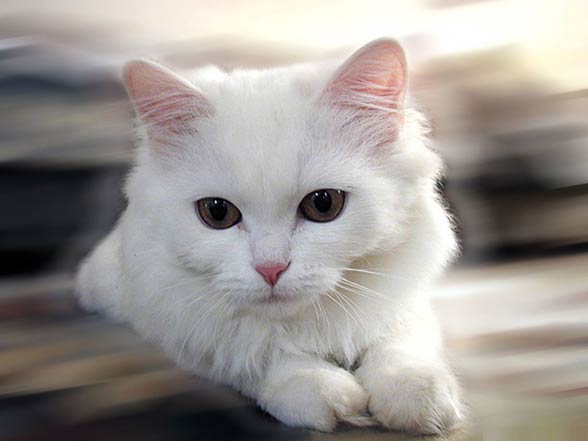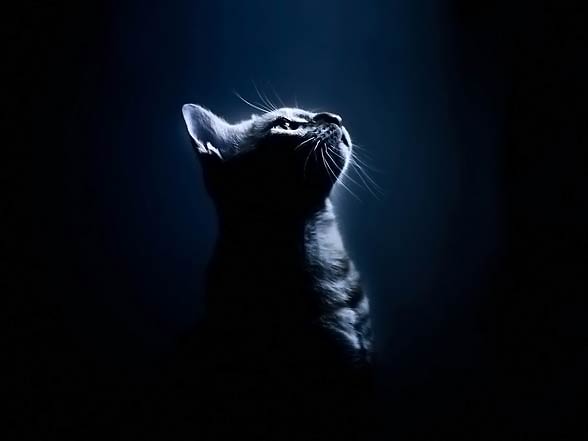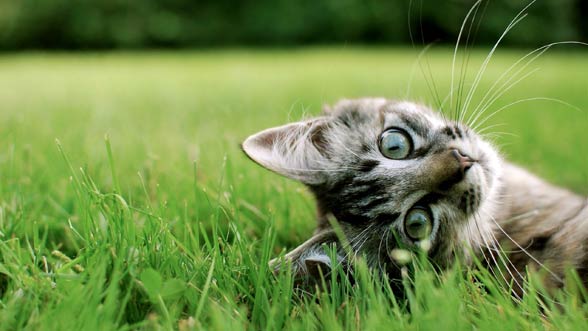Smart cat?
Intelligence, contrary to appearances, is a rather relative concept. Stanley Coren’s ranking of the most intelligent dogs suggested a level of obedience. Personally independent breeds such as the Caucasian Shepherd’s fell out rather poorly, comparing to friendly Labradors.
If Coren applied similar criteria to cats, they would probably find that almost none of them are intelligent. However, the truth is not so obvious, because the kitten’s intelligence is a completely “different kettle of fish” than the intelligence of dogs. So let us learn, what it manifests itself in, and what determines its level.
After reading this article, we invite you to get acquainted not only with wise dogs and cats, but also with the wisest animals in general.

Structure of the cat’s brain
The brain structure of a domestic cat is very similar to that of a human being. The greatest similarity can be seen in the cerebral cortex, which in both species is strongly undulating and consists of similar lobes.
Researchers at the Tufts University School of Veterinary Medicine have shown that the brain of a cat has been divided into many areas, each of which has its own specialization in different tasks. Of course, this does not mean that the cat has a few smaller brains that act independently of each other, as these areas are connected by a number of radially arranged paths (the so-called hub-and-spoke network). This applies mainly to the area responsible for the action of the senses. With this type of sensory information exchange, the cat can correctly perceive, react to and influence the world around it.
The number of cortical neurons in cat’s brain is about 763 million. Area of the visual cortex contains about 51,400 neurons per mm3.

Encephalization quotient (EQ)
We wrote about the encephalization quotient in the article describing the most intelligent animals. A domestic cat measures approximately 60 cm in length on average and weighs 3.3 kg. His brain measures approx. 5 cm long and weighing between 25 and 30 g. This organ, therefore, represents 0.91% of the total body weight. In an average person, this ratio is a maximum of 2.33%, unless he/she is thicker, then, much, much less ;). As you can see, it is worth keeping in shape all the time 🙂
Based on the encephalization quotient created by Jerison in 1973, a value above 1 is assumed to be classified as big-brained, below 1 as small-brained. In a domestic cat, this factor has been calculated to be 1-1.71 (7.44-7.8 in humans).

Domestic cat intelligence level
Intelligence is usually defined as a set of abilities and skills. In adults (people), this intelligence is measured using the WAIS test (Wechsler Adult Intelligence Scale). This is an IQ test, which includes verbal understanding, the speed of information processing and the performance of the working memory (ability to store and process information).
Domestic cats have also been tested by WAIS. It turned out that they kept the new information for about 16 hours. Further research has shown that cats are aware of objects they do not currently see and that their sensory skills are comparable to those of a 2-year-old child. There are also indications that cats can remember the facts of their lives up to 10 years ago. They probably also have dreams, as evidenced by the fast movement of the eyeballs during sleep, i.e. the presence of the REM phase in which a human experiences dreams.

Memory
Domestic cats certainly have a lot of memories, but criteria such as relationships with people, individual differences in intelligence levels, and age can all have a significant impact on memory quality.
One thing to know is: cats, as close relatives of wild predators, are still well adapted to the environment with clear rules. Even today, in such conditions, they are more able to recall what they have learned in the past and to adapt these memories to the current situation.
A good memory can therefore be “pulled up” under the method of protection against predators. So if the cat once learns to defend against the attacker, a cat will manage it for the second, tenth and hundredth time.

Cat’s memory and age
As with humans, cats also have the best memory at an early age. A great memory is a potential that kittens neatly use while playing hunts. These seemingly innocent fools will save your cat’s life and help him to get food in the future.
Before cats were domesticated, they also learned from their mothers’ observations about where to find food and what to use in their adult lives.
A breakthrough period in the life of a kitten is the first 7 weeks of life when it establishes a bond with other cats. It is also possible that if the cat is not in contact with a human at this time, he will never trust any of them again.
Older cats may have weakened memory and learning ability, which is very similar to people. This slowdown in brain function is not abnormal, it is simply a symptom of an aging body. The aging of the feline and the human brain is similar in a way that is related to the death of brain cells.

Learning
The most famous experiment involving cats was conducted by Edward Thorndike, who proved that these animals could learn through instrumental conditioning. It consists of strengthening the behaviors desired by rewarding and quenching undesirable by punishing.
In this experiment, cats were placed in boxes measuring 50 cm in length, about 40 cm in width and about 30 cm in height. Each such block was closed by a door that the cat had to open if he wanted to get to the food. It turned out that the cats were released from these boxes using the trial and error method ended with accidental success.
Repeated experiments with the same cats showed that these animals retain new skills in long-term memory. Experienced individuals were able to open the door faster than the first time. Thorndike therefore concluded that cats have the ability to learn on the basis of the so-called the law of effect, which states that responses followed by satisfaction (i.e. a reward) become more likely responses to the same stimulus in the future. Thorndike was generally skeptical of the presence of intelligence in cats, criticizing sources of the contemporary writing of the sentience of animals as partiality in deductions from facts and more especially in the choice of facts for investigation.

Cause and effect
In 2009, further experiments involving cats were carried out. This time the task of the subjects was to get a delicacy combined with a string. When the cat had only one string to choose from, he quickly realized that he had to pull for it to get food.
But when the cat was shown a few strings, of which only some were combined with food, cats were not able to choose the appropriate strings. It led to the conclusion that cats did not understand the cause-and-effect relationship as humans understood it.

Kittens and learning through observation
Experiments have also been carried out to test the ability of cats to learn through observation. Kittens have been tested for this. Young cats that were able to observe their mothers’ actions were then able to repeat this earlier than kittens who were observing the behavior of unrelated cats.
For comparison, research on chimpanzees has shown that they have a certain level of knowledge in the field of learning through observation. Cats, on the other hand, do not have this knowledge.

Cat intelligence and domestication
The domestication process has certainly affected not only the brain of a domestic cat, but also its genome. Both were certainly most affected by selective breeding, during which man significantly interfered and continues to interfere in the process of evolution of domestic cats. The aim of selective breeding was not to maintain the wildest instincts, but on the contrary to strengthen or create features that would allow the cat to live side by side with humans, while at the same time (not in the case of all breeds) being able to hunt rodents, among other things.
It seems that a cat’s intelligence is therefore highly dependent on its relationship with humans, whether it lives under stress or has plenty of freedom and ability to explore its world. If its brain is enriched and stimulated by environmental stimuli, the plasticity of the brain increases. This makes it easier for your cat to adapt to new circumstances. Similar changes were probably observed in the brains of early hominids coexisting with primitive felids, such as Machairodontinae, Homotherium or Megantereon.

Cat intelligence – interesting facts
- The frontal lobe, responsible for movement planning, thinking and memory, comprises 3.5% of the total brain in cats. In humans, this lobe comprises about 25% of the brain.
- The largest brain in the family of felids had Bali tigers (Panthera tigris balica).
- The surface area of a cat’s cerebral cortex is approximately 83 cm2 (13 in2) whereas the human brain has a surface area of about 2,500 cm2 (390 in2).
- In order for the domestic cat’s brain to function efficiently, its diet should be rich in vitamins D, B1 and B6, as well as manganese, potassium, calcium, sodium and magnesium. The necessary for the life of this domesticated predator is also taurine – a biogenic amino acid. Its deficiency leads to retinal degeneration as well as heart failure.
- Cats, although very independent, can be trained. The proof is the Moscow Cat Theater. The owner of this sanctuary, Yuri Kuklachev, has been training cats for many years. His pupils are able to perform many circus tricks.



















